Types and purpose of jackhammers
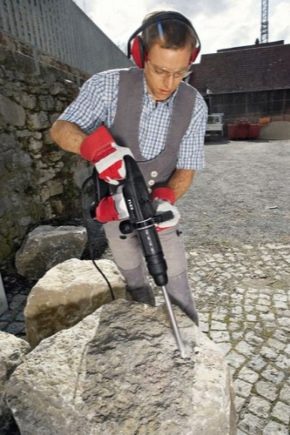
Jackhammers seem to be familiar to all people. It is difficult to find those who have never seen how they smash asphalt or tiles, demolish walls. But not everything is so simple.
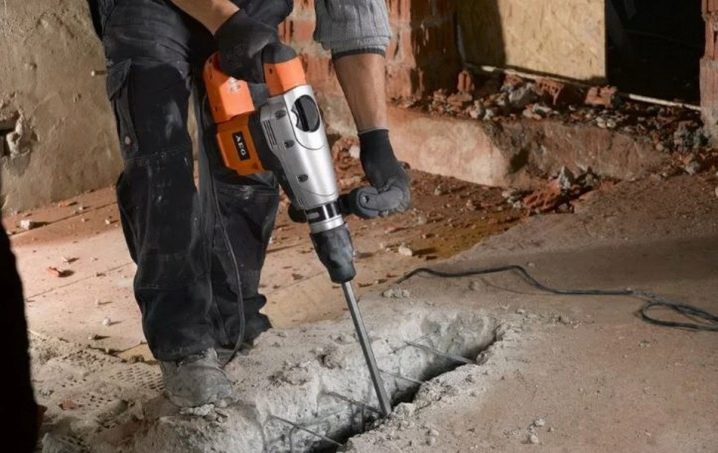
Peculiarities
This type of construction tool, such as a jackhammer, works due to the impact effect. It is used to:
- destroy the laid asphalt;
- open up durable materials;
- remove "difficult" coatings;
- break openings;
- punch holes in the main and secondary walls;
- to extract resources in mines and mines;
- gouge walls;
- cut metal;
- perform rescue operations.


Device and principle of operation
The jackhammer works according to a very simple principle:
- the motor transmits the force to the firing pin located inside the body;
- from the striker, the impulse goes to the chisel;
- the shock part under the action of the received impulse can oscillate at a speed of up to 25 beats per second.


This interaction between the components of the hammer allows you to quickly break various materials.
Chippers quickly replaced heavy hand hammers, hanging weights, and explosives. As it turned out, they are very productive and allow you to work much more efficiently. Using a jackhammer, you can work not only faster, but also with the highest possible quality: you can save individual blocks for later use. It is not for nothing that such a tool is used not only by professional, but also by amateur builders.

Views
By weight
The wide range of applications of jackhammers is achieved due to the specific differences between the individual models. So, the lightest devices (weighing less than 6 kg) are used mainly for domestic purposes. They can confidently cope with crushing tiles, plaster, relatively thin cement floors. Devices of the middle weight category are widely demanded by builders, they are used to break asphalt. The most powerful devices weigh up to 30 kg and are needed mainly in large-scale construction work.


By drive type
Air-powered demolition hammers are the most commonly used options. Compressed air is produced using a compressor. The chisel moves under the action of the air flow. Air-driven household appliances must strike with a force of at least 5 J. For industrial units, the requirement is twice as high. Such characteristics make it possible to:
- destroy sidewalks;
- demolish buildings made of natural or artificial stone;
- breaking through concrete and so on.


Electric hammers are equipped with special internal strikers. The strikers are driven by rotating parts. Motorized units can easily break a wall or covering. But it is important to understand that the high power of the force generated by the electric motor is not always good. This property makes it difficult to fully drill and cut materials. Problems can also be associated with the appearance of sparks. They are found even in the most reliable models. Due to this feature, electrical devices cannot be used in places with high fire risks. Conventional models are not capable of operating disconnected from the mains. Battery versions can be considered an exception, however, they are heavier than analogue plugged into an outlet.


Hourly current consumption (in terms of continuous operation) reaches 1.7 kW.Each blow has a force of 45 J, and such blows are delivered 2000 times per minute. Important: all modern models of fenders with an electric motor are equipped with double insulation, so you can connect the device to a home outlet without any fear. The gasoline (aka gasoline breaker) hammer is easy to use. Such mechanisms can work even where there is no electricity and it is not very convenient to use compressors. Versions with internal combustion engines, in addition, are safer than electric or pneumatic deflector systems. But it must be borne in mind that the heat engine creates a lot of noise. And you also have to constantly pour fuel into the tank, that is, the continuity of work is a big question.


Gasoline powered jackhammers perform well:
- when rocky and icy soil is destroyed;
- when dismantling asphalt and concrete;
- in the process of extracting resources.

Chippers with internal combustion engines help in a short time to break materials of different hardness. The size of the processed blocks does not play a special role either. Hydraulic devices deservedly stand out in a separate group. There are various devices for them. Basically, the hydraulic chipper, due to its versatility and high performance, is used by rescue teams.

By the shape of the body
There is no need to talk a lot about the geometry of the body of construction jackhammers. Even in publications where their types are examined in detail, this topic is not covered. Everything is completely predictable: outwardly it is a rod with a tip of various shapes. But there are also externally similar riveting hammers that allow you to work effectively with large steel and aluminum rivets. The weight of such devices exceeds 3 kg, and in size they are very voluminous.

Air chipping hammers also deserve attention. They are helping:
- remove excess deposits on the surface of castings;
- clean parts of gating systems;
- clean out the burn.


When chopping off castings, slide hammers are preferred. How large castings can be machined depends on the stroke length of the striker. Different types of chisels can be used to process different types of castings. Not only the type of material is taken into account, but also previous manipulations with it. So, if annealing has been carried out, special shaped tips are required.
Subtleties of choice
But it is not only the geometry of the jackhammer and the type of its drive that matters - each type of attachments determines the ability to perform certain specific work. So, the picks-"crowbars" are designed to:
- loosen the soil;
- demolish brick and concrete walls;
- dismantle the old road surfaces;
- process minerals, mountain stone.


A shovel is needed if you have to level asphalt edges and also break ice. A wide range of materials are cut with a chisel. Accordingly, the functionality of the jackhammer directly depends on compatibility with certain attachments. The mass of a specific bump stop deserves a separate discussion. So, a tool weighing up to 6 kg is chosen if it is planned to work at a height, and the heaviest (30 kg and above) allow you to work with soil, break old foundations.

As already mentioned, only pneumatic hammers can be used in a fire hazardous environment. However, hose characteristics are critical when selecting them. The connecting diameter is not suitable, which means that it will not be possible to work. The same will happen if there is not enough length. Of course, they also take into account:
- type of material;
- wall thickness;
- diameter and inner section;
- permissible pressure level.
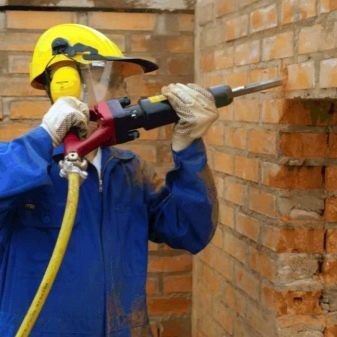
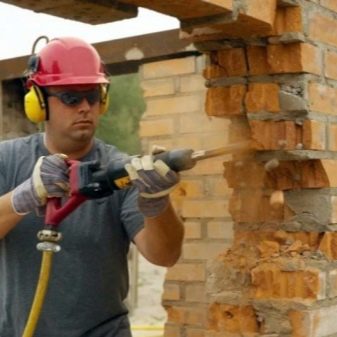
The pneumatic apparatus, which strikes with a force of 30 Joules, can successfully work on weight, as well as in confined spaces. If it is not clear in advance what specific work is to be carried out, it is necessary to take a universal technique. She strikes at 40 J.But for concrete, natural stone and other very tough materials, chippers with an impact energy of 50 J or more are recommended. We must not forget whether it is convenient to hold the tool in our hands - very powerful devices are often heavy.

The weight limitation is significant for pneumatic, electric, and gasoline systems. In the last two cases, experts recommend taking into account the motor power. The severity of the device should be maximized if it is planned to break the old floor or perform other complex work. But for the treatment of walls and other vertical surfaces, it is worth taking something easier.
As always, you need to pay attention to the brand of the manufacturer, to take into account his reputation. Some of the firms that make jackhammers produce quality goods. But there are those who supply frankly bad products. Important: bona fide manufacturers are not only among the leaders of the world and domestic markets. It is impractical to buy electrical devices that are not equipped with a button lock: you will have to constantly hold the start toggle switch manually.


Devices with an idle frequency limit work much longer and more efficiently. This limitation is extremely simple. As soon as the sensor detects a drop in load intensity, the engine speed drops on command. But as soon as the load rises, the revolutions become higher. The vibration damping complex is of great use. If it is not provided by the designers, it will be more difficult for the operators, moreover, there will be considerable health risks.

Finally, for a more accurate and competent choice, it is useful to analyze the characteristics of individual brands of jackhammers. The bumpers from the Japanese corporation Makita deservedly have a very good reputation. This company has been supplying power tools for over 100 years. Removing and installing the caps on the bumpers of the Japanese brand can be quickly and completely safe. The developers have provided built-in blocks that regulate the number of revolutions per minute.

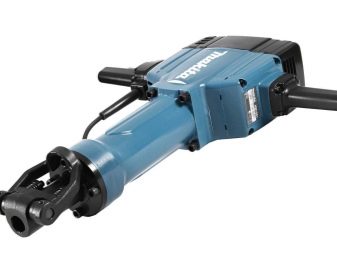
Good results are also achieved with Bosch demolition hammers. The German concern values its reputation and carefully monitors the quality of finished products. Importantly, the packaging is marked with a list of basic characteristics - choosing the most suitable modification is not difficult. You can also consider bumpers Hitachi, "Zubr", DeWalt and other domestic, foreign manufacturers that have proven themselves well.


Operating tips
When working with jackhammers, it is necessary to use crowns of the stronger strength, the harder the material to be processed. When processing asphalt or granite, use wide crowns. But penetration is strictly limited, otherwise there is a great danger that the tool will be blocked. If this does happen, the hammer will have to be rocked - then it will be possible to remove it quickly and easily. It is possible to hammer concrete of strong grades only with bumpers with special peaks. The extended working surface of these nozzles makes it easier to separate the layers of material. For crumbling rock or asphalt, a T-shaped handle is preferred, but when working at an angle to the surface, D-shaped holders are recommended.

Fill the newly purchased bump stop with grease three or four times during the shift until 2 weeks of operation have passed. Then the oil will have to be poured twice in a standard shift. Attention: the hammer must not bounce during operation. If this happens, something is clearly being done wrong. The oil is usually added via a grease nozzle and, if not available, a nipple is used.

It must be remembered that bumpers almost always break due to overloading and improper use. Therefore, their power must always correspond to the complexity of the work performed. It takes no more than 25 minutes to continuously hammer the wall, asphalt, and so on. After that, a pause is made for at least 10 minutes.Before loading the lance into the bump stop, it is required to lubricate the shanks with greases.
For information on how to use the jackhammer correctly, see the next video.













The comment was sent successfully.